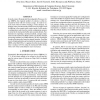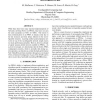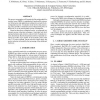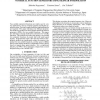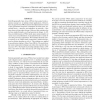FPL
2008
Springer
14 years 1 months ago
2008
Springer
Many of today's software-to-hardware compiler projects try to find dataflow parallelism in a sequential program description and use it to generate parallel running hardware c...
FPL
2008
Springer
14 years 1 months ago
2008
Springer
In multi-context Dynamically Reconfigurable Processor Array (DRPA), the required number of contexts is often increased by those with low resource usage. In order to execute such c...
FPL
2008
Springer
14 years 1 months ago
2008
Springer
FPGA devices have witnessed popularity in their use for the rapid prototyping of biological Spiking Neural Network (SNNs) applications, as they offer the key requirement of reconf...
FPL
2008
Springer
14 years 1 months ago
2008
Springer
While there have been many reported implementations of Networks-on-Chip (NoCs) on FPGAs, they have not seen the same acceptance as NoCs on ASICs. One reason is that communication ...
FPL
2008
Springer
14 years 1 months ago
2008
Springer
The power consumption of Dynamically Reconfigurable Processing Array (DRPA) is quantitatively analyzed by using a real chip layout and applications taking into account the reconfi...
FPL
2008
Springer
14 years 1 months ago
2008
Springer
Two-variable numerical functions are widely used in various applications, such as computer graphics and digital signal processing. Fast and compact hardware implementations are re...
FPL
2008
Springer
14 years 1 months ago
2008
Springer
Field-Programmable Gate Arrays (FPGAs) have gained wide acceptance among low- to medium-volume applications. However, there are gaps between FPGA and custom implementations in ter...
FPL
2008
Springer
14 years 1 months ago
2008
Springer
In the context of FPGAs, system downgrade consists in preventing the update of the hardware configuration or in replaying an old bitstream. The objective can be to preclude a syst...
FPL
2008
Springer
14 years 1 months ago
2008
Springer
The effectiveness of implementing bit-stream signal processing (BSSP) multiplier circuits in FPGAs, in terms of hardware resources and clock frequency, is presented. In particular...
FPL
2008
Springer
14 years 1 months ago
2008
Springer
Adaptive computers combine conventional software programmable processors with reconfigurable compute units. We present techniques that allow the high-performance realization of de...

